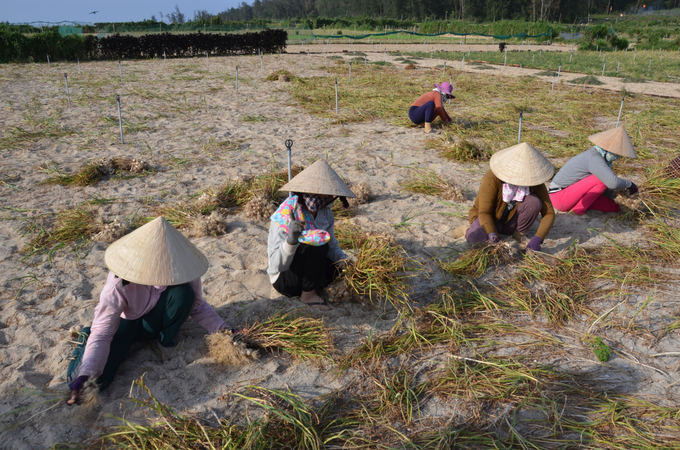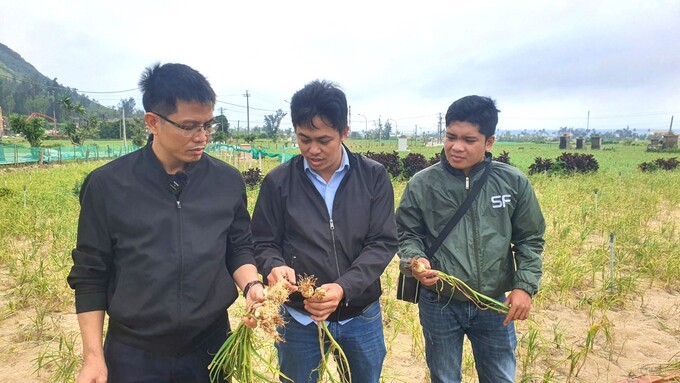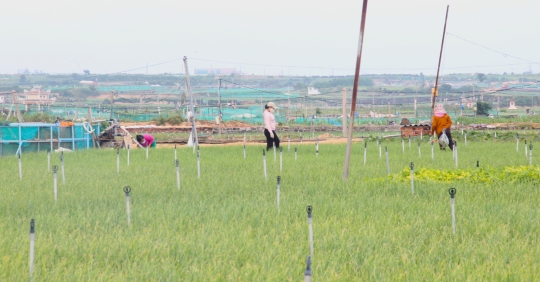challenges in practice
Garlic is a traditional crop in Ly Son District (Quang Ngai Province). Ly Son garlic brand is well known throughout the country for its distinctive flavor and is very popular in the market. However, the garlic production of the people of this district faces many difficulties due to weather, pests and diseases, an unstable consumer market and precarious prices.

The garlic area in Ly Son district is currently about 330 ha. Image: LK
Garlic production in the Ly Son district is still mainly based on the traditional method. Accordingly, people will add soil every 1 to 2 years and replace sand once in the field. The soil source for garlic production is mainly local basalt red soil and coral sand sucked up from the seabed.
Basalt soil is replenished from the foothills by deep excavations or extractions. This layer of soil has the effect of providing nutrients, retaining water, and controlling pests and diseases. Coral sand covering the surface retains moisture, cleans leaves when it rains and cools bulbs when it’s sunny, limits pests and diseases, creates porosity for tuber development, thus increasing yield and quality of garlic plants.
With the current garlic production area in Ly Son district of about 330 ha, hundreds of thousands m3 of soil and sand have to be replaced and removed every year on this island country. The consequences lead to the general ecological environment of the entire district, especially the marine ecological environment, which is being affected by the ongoing erosion with great intensity and high speed. In addition, this approach also incurs quite high costs.
And yet traditional garlic cultivation has faced many challenges in recent years, resulting in the value of this specialty crop not living up to its potential. Among them are: the product has not yet ensured food safety and hygiene due to pesticide spraying, mainly against it, with little consideration of the main prevention plan; origin not traceable; there are not many effective linkage models; the problem of trademark protection is not good; The garlic harvest takes place in the rainy season, which leads to a high risk.

In recent years, people’s garlic cultivation in Ly Son District has often faced many difficulties due to weather, pests and diseases. Picture: LK
At the same time, according to the socio-economic development project, Ly Son District will focus on tourism development investment by 2025. Limited space, growing infrastructure mean that the areas for agricultural production are shrinking. Meanwhile, this district still determines that garlic is the main crop, so the problem is to increase the value of Ly Son garlic and ensure sustainable development.
With this in mind, in 2015-2017, Quang Ngai Province carried out an experimental garlic cultivation technical solution project in Ly Son Island District. Rather than adding soil and replacing coral sand, the cultivation method in the study involves plowing the underlying basalt layer, combining organic and inorganic fertilizers, and applying engineering measures. At the same time add the levels of substances found in coral sand such as calcium, magnesium, sulfur…then use a layer of dead vegetation to cover them to keep the bottom cool.
The results showed that the garlic plant was still growing and developing well, the yield did not decrease. Through analysis, the quality of garlic bulbs is still guaranteed as people’s traditional cultivation method. Only one problem remains when removing the old coral sand layer, the high proportion of clay in the soil makes the garlic harvest more difficult and causes additional costs. However, at the end of the topic, there are no more solutions to perfect and replicate this method.
The future is wide open
Developing from the above theme, in March 2021, Quang Ngai started to implement the project “Research and synchronous application of scientific and technological solutions for the production, preservation and processing of Ly garlic. Sustainable paint along the value chain”. The implementation period is 36 months.
This is a national-level project chaired by Nong Tin Science and Technology Co., Ltd. in collaboration with the South Central Coast Institute of Agricultural Science and Technology; Fruit and Vegetable Research Institute (Vietnam Agricultural Science Institute) and Ly Son District Agricultural Service Center.

The research project on the synchronous application of scientific and technological solutions for sustainable production, preservation and processing of Ly-Son garlic according to the value chain has been implemented from 2021. Photo: LK
According to Mr. Vu Van Khue, Deputy Director of the Institute of Agricultural Science and Technology of the South Central Coast (technical advisory unit for the project), adopting the cultivation method from the previous topic is not to add red basalt soil nor replace new coral sand, but this study considered the retention of the entire old coral sand layer, which was then plowed with basalt soil to a depth of about 20 cm to form a loose sandy soil layer that is porous and ensures soil properties and is easier to harvest.
When plowing, the soil has a very porous sandy nature, thanks to which the roots of the garlic plant grow strong, deep and wide, they are able to withstand spills, get better water and nutrients, garlic plants grow, develop well, better resilient against pests, diseases and adverse weather conditions.
In the past, people often compacted the basalt soil and then cultivated it on top of the sand layer, so the garlic roots developed poorly, only growing horizontally and not spreading widely. Faced with adverse weather conditions such as wind and storm, it is easy to fall down, drought, poor water absorption, narrow nutrient supply, so garlic plants grow and develop poorly, easily affected by pests and diseases, reducing yield and costing fertilizers, pesticides and irrigation water.

Garlic plants in the model show good growth and development, high yield and quality. Picture: LK
After the theme was tested and successfully received in the garlic harvest of 2021-2022, the implementing units have implemented a model of linking production and consumption of garlic products by this year’s garlic harvest (2022-2023). Ly Son is safe according to VietGAP standards on an area of 10ha. This production season, Ly Son’s garlic plants were seriously affected by persistent rainy weather, and pests and diseases caused severe damage, resulting in severe crop failures. Many people’s areas have lost 80-90% of their productivity, but the garlic model fields still have high and stable yields.
“By cultivating the soil, increasing the use of organic fertilizers, reducing inorganic fertilizers, and a combination of integrated pest control and management measures, garlic is doing very well in the model field; all growth indicators are excellent; The garlic bulbs are firm, the yield is expected to reach 6.34 tons/ha, while the average field mass is only 4.23 tons/ha.
Although the production costs in the model field are somewhat higher due to the high use of organic fertilizers of all kinds for priming, the profitability is significantly higher. If the net profit of the mass field in this crop is only nearly 70 million dong/ha, the model field will reach 307 million dong/ha because of the increased productivity and selling price,” said Vu Van Khue.
Currently, according to Mr. Khue, there is still a problem with the cultivation of garlic and onions of the Ly Son that needs to be overcome, which is that people in the same field still keep the old cultivation method, 1 garlic harvest and 2 harvests per year – 3 consecutive executions . These are two types of crops in the same family, so continuous production is easy for potential sources of pests in the soil and crop residues from the previous crop.
Therefore, this unit recommends that people must alternate between harvesting garlic and harvesting onions with other crops such as peanuts, sesame, corn, etc. This method not only cuts the source of pests and diseases, improves the soil, but also uses corpse crops are rotated as a covering material. At the same time, these mulch materials, in combination with tillage after each harvest, also cause organic fertilization of the soil.

The garlic roots in the model grow strongly, so the ability to absorb water and nutrients is good, and it can withstand adverse weather conditions. Picture: LK
Mr. Phan Son, representative of the unit responsible for the project (Nong Tin Science and Technology Co., Ltd.), said that this is a topic of great scientific importance, which not only helps the people of Ly Son improve their cultivation practices change the issue of tillage and control of fertilizer and pesticide residues, but also a new method to improve yield and efficiency of garlic in the face of frequent crop failures in recent years.
The model has shown the production linkage between the ‘4 houses’: the state, scientists, corporations and farmers. After the farmers harvest, this unit is also based on actual demand, yield statistics and buying produce at higher prices than the market.
“Currently, we are building and installing the garlic processing factory equipment right on this island district. We process garlic bulbs, which are currently only sold raw or small, unsaleable garlic, into branded products. In 2023, we will definitely be able to launch products,” said Mr. Phan Son.
associate Prof. Dr. Nguyen Quoc Hung, Director of Ly-Son Garlic Fruit and Vegetable Research Institute, this unit is currently improving and completing the preservation process to reduce the damage and loss rate over time.6 to 9 months depending on temperature conditions. In addition, the institute has also perfected the processing technology of black garlic, black garlic honey juice, garlic powder and garlic sauce as a seasoning to produce quality products.
“If there is a processing plant in the future, we will apply these technologies under practical conditions to organize the production of Ly Son garlic in a sustainable way.”

